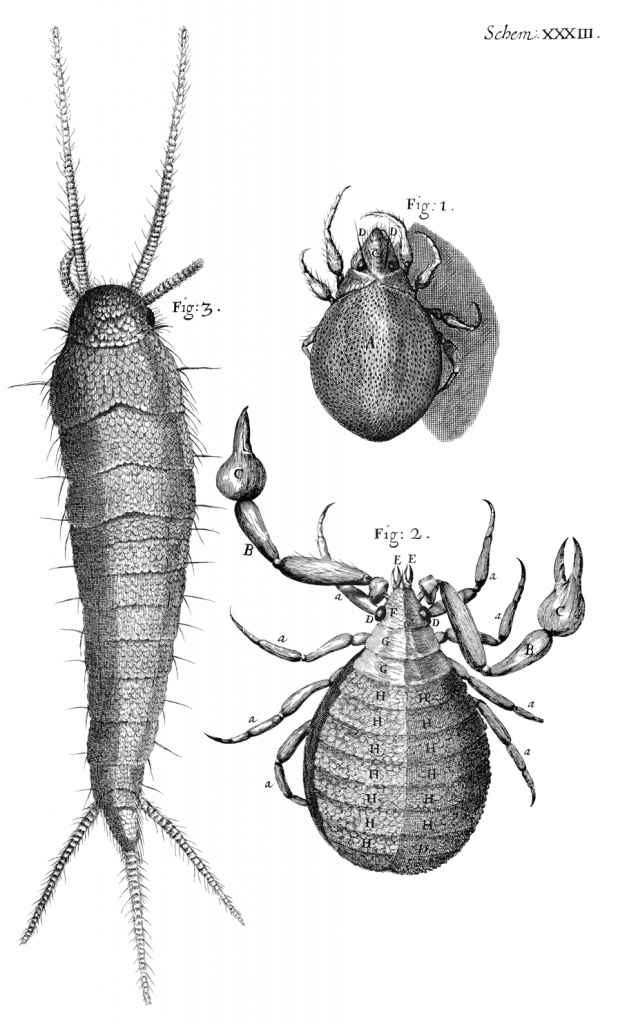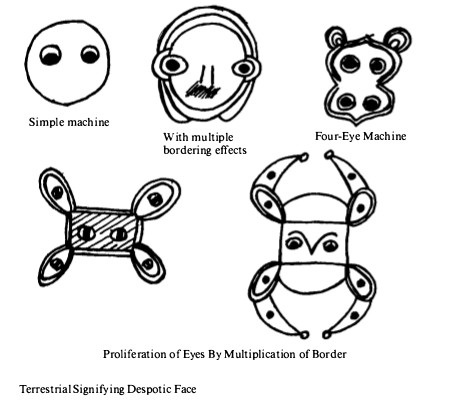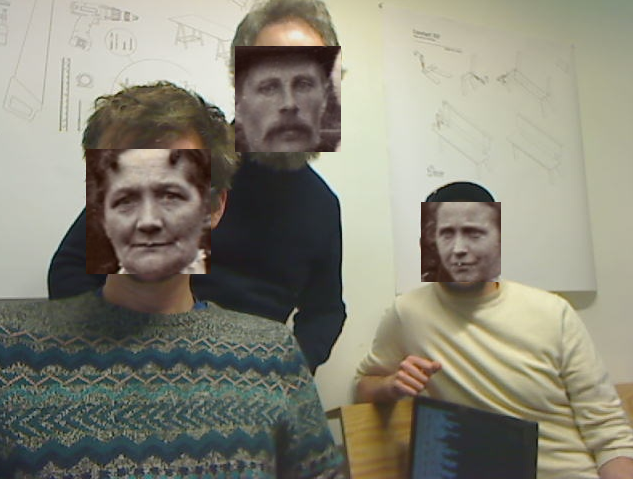A book worm’s micrography
From http://www.ucmp.berkeley.edu/history/hooke.html
Hooke’s reputation in the history of biology largely rests on his book Micrographia, published in 1665. Hooke devised […] one of the best such microscopes of his time, and used it in his demonstrations at the Royal Society’s meetings. With it he observed organisms as diverse as insects, sponges, bryozoans, foraminifera, and bird feathers. Micrographia was an accurate and detailed record of his observations, illustrated with magnificent drawings […] It was a best-seller of its day. Some readers ridiculed Hooke for paying attention to such trifling pursuits: a satirist of the time poked fun at him as “a Sot, that has spent 2000 £ in Microscopes, to find out the nature of Eels in Vinegar, Mites in Cheese, and the Blue of Plums which he has subtly found out to be living creatures.” More complimentary was the reaction of the diarist and government official Samuel Pepys, who stayed up till 2:00 AM one night reading Micrographia, which he called “the most ingenious book that I ever read in my life.”

From Micrographia:
Observ. II. Of the small Silver-colour’d Book-worm.
As among greater Animals there are many that are scaled, both for ornament and defence, so are there not wanting such also among the lesser bodies of Insects, whereof this little creature gives us an Instance. It is a small white Silver-shining Worm or Moth, which I found much conversant among Books and Papers, and is suppos’d to be that which corrodes and eats holes through the leaves and covers; it appears to the naked eye, a small glittering Pearl-colour’d Moth, which upon the removing of Books and Papers in the Summer, is often observ’d very nimbly to scud, and pack away to some lurking cranney, where it may the better protect itself from any appearing dangers. Its head appears bigg and blunt, and its body tapers from it towads the tail, smaller and smaller, being shap’d almost like a Carret.
This the Microscopical appearance will more plainly manifest, which exhibits, in the third Figure of the 33. Scheme, a conical body, divided into fourteen several partitions, being the appearance of so many several shels, or shields that cover the whole body, every of these shells are again cover’d or tiled over with a multitude of thin transparent scales, which, from the multiplicity of their reflecting surfaces, make the whole Animal appear of a perfect Pearl-colour.
[…]
The small blunt head of this Insect was furnish’d on either side of it with a cluster of eyes, each of which seem’d to contain but a very few, in comparison of what I had observ’d the clusters of other Insects to abound with; each of these clusters were beset with a row of small brisles, much like the cilia or hairs on the eye-lids, and, perhaps, they serv’d for the same purpose. It had two long horns before, which were streight, and tapering towards the top, curiously ring’d or knobb’d, and brisled much like the Marsh Weed, call’d Horse-tail, or Cats-tail, having at each knot a fring’d Girdle, as I may so call it, of smaller hairs, and several bigger and larger brisles, here and there dispers’d among them: besides these, it had two shorter horns, or feelers, which were knotted and fring’d, just as the former, but wanted brisles, and were blunt at the ends; the hinder part of the creature was terminated with three tails, in every particular resembling the two longer horns that grew out of the head: The leggs of it were scal’d and hair’d much like the rest, but are not express’d in this Figure, the Moth being intangled all in Glew, and so the leggs of this appear’d not through the Glass which looked perpendicularly upon the back.
This Animal probably feeds upon the Paper and covers of Books, and perforates in them several small round holes, finding, perhaps, a convenient nourishment in those hulks of Hemp and Flax, which have pass’d through so many scourings, washings, dressings and dryings, as the parts of old Paper must necessarily have suffer’d; the digestive faculty, it seems, of these little creatures being able yet further to work upon those stubborn parts, and reduce them into another form.
And indeed, when I consider what a heap of Saw-dust or chips this little creature (which is one of the teeth of Time) conveys into its intrals, I cannot chuse but remember and admire the excellent contrivance of Nature, in placing in Animals such a fire, as is continually nourished and supply’d by the materials convey’d into the stomach, and fomented by the bellows of the lungs; and in so contriving the most admirable fabrick of Animals, as to make the very spending and wasting of that fire, to be instrumental to the procuring and collecting more materials to augment and cherish it self, which indeed seems to be the principal end of all the contrivances observable in bruit Animals
Innate species
Although every “acquired species” comes through imagination, Bonaventure creates another category of species, called innate species, that are imprinted directly on the memory. Bonaventure writes, “Memory has to be informed not only from the outside by phantasms but also from the above, by receiving and having in itself simple forms that cannot enter through the doors of the senses, nor through sensible phantasms.”
Imagination, Meditation, and Cognition in the Middle Ages, Michelle Karnes.
Homunculus argument
 Original work: Jennifer Garcia,, Derivative work: Pbroks13, and Was a bee. CC BY-SA 2.5-2.0-1.0
Original work: Jennifer Garcia,, Derivative work: Pbroks13, and Was a bee. CC BY-SA 2.5-2.0-1.0
One may explain (human) vision by noting that light from the outside world forms an image on the retinas in the eyes and something (or someone) in the brain looks at these images as if they are images on a movie screen […]. The assumption here is that there is a ‘little man’ or ‘homunculus’ inside the brain ‘looking at’ the movie.
(more…)
What would the world look like to someone with a bionic eye?
From a press release from the University of Washington:
“Various sight recovery therapies are being developed by companies around the world, offering new hope for people who are blind. But little is known about what the world will look like to patients who undergo those procedures.
A new University of Washington study seeks to answer that question and offers visual simulations of what someone with restored vision might see.”
“The first panel shows the ideal ‘scoreboard model’ – what we’re trying to achieve.
The middle panel shows a simulation of the effects of electrical stimulation. We assume that electrical stimulation will simultaneously cause responses in both ON- and OFF pathways – that’s what causes the weird edge effects, and will also result in some stimulation of ganglion cell axons – that’s what causes the ‘streaks’.
The right panels shows a simulation of optogenetics and small molecule photoswitch stimulation. This movie is based on assuming that only ON-centre retinal pathways are selectively stimulated – that causes the edge effects, and the timing of responses is sluggish compared to natural vision – that’s what causes the child on the scooter to ‘disappear’.”
Read more.
They Live, or an image OCR for ideology
“The plot of They Live is deceptively simple. Roddy Piper’s character, a semi-homeless day laborer named Nada (Spanish for “nothing”) discovers a pair of sunglasses that allow him to identify the extraterrestrials who have infiltrated the Earth’s populace.” (Read more about the story plot on salon.com)
In a fashion very similar to computer vision procedures, the glasses first discard color information. They then convert or translate images into text. More precisely into orders. Watching the images makes you a slave who obeys without knowing it to these injunctions. Using the glasses, you are then able to read instead of watching. It is interesting to note that Carpenter does not choose to display the text as a subtitle or comment to these images, but to replace them. Using the glasses, the modes are switched. They cannot coexist. The glasses are not only a sort of OCR for ideology, they also detect faces. Or more precisely, reverse-detect them. When seeing an alien with the glasses, its face becomes a dead mask, the alien looses its faciality.
Eyes for visually impaired
“Dulight uses technologies in deep learning, image recognition and speech recognition to help visually impaired people identifying people and objects in their lives.”
like four-eye machines made of elementary faces linked together two by two

[…] The face is not a universal. It is not even that of the white man; it is White Man himself, with his broad white cheeks and the black hole of his eyes. The face is Christ. The face is the typical European, what Ezra Pound called the average sensual man, in short, the ordinary everyday Erotomaniac (nineteenth-century psychiatrists were right to say that erotomania, unlike nymphomania, often remains pure and chaste; this is because it operates through the face and facialization). Not a universal, but facies totius universi. Jesus Christ superstar: he invented the facialization of the entire body and spread it everywhere (the Passion of Joan of Arc, in close-up). Thus the face is by nature an entirely specific idea, which did not preclude its acquiring and exercising the most general offunctions: the function of biunivocalization, or binarization. It has two aspects: the abstract machine of faciality, insofar as it is composed by a black hole/white wall system, functions in two ways, one of which concerns the units or elements, the other the choices. Under the first aspect, the black hole acts as a central computer, Christ, the third eye that moves across the wall or the white screen serving as general surface of reference. Regardless of the content one gives it, the machine constitutes a facial unit, an elementary face in biunivocal relation with another: it is a man or a woman, a rich person or a poor one, an adult or a child, a leader or a subject, “an x or a y.” The movement of the black hole across the screen, the trajectory of the third eye over the surface of reference, constitutes so many dichotomies or arborescences, like four-eye machines made of elementary faces linked together two by two. The face of a teacher and a student, father and son, worker and boss, cop and citizen, accused and judge (“the judge had a stern expression, his eyes were horizonless . . . “): concrete individualized faces are produced and transformed on the basis of these units, these combinations of units-like the face of a rich child in which a military calling is already discernible, that West Point chin. You don’t so much have a face as slide into one.
G. Deleuze, F. Guattari, A Thousand Plateaus
(more…)
